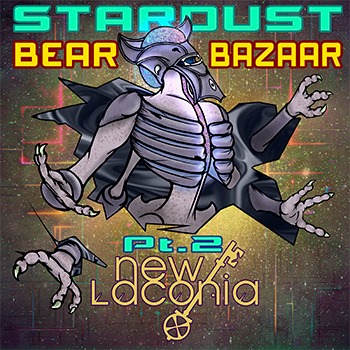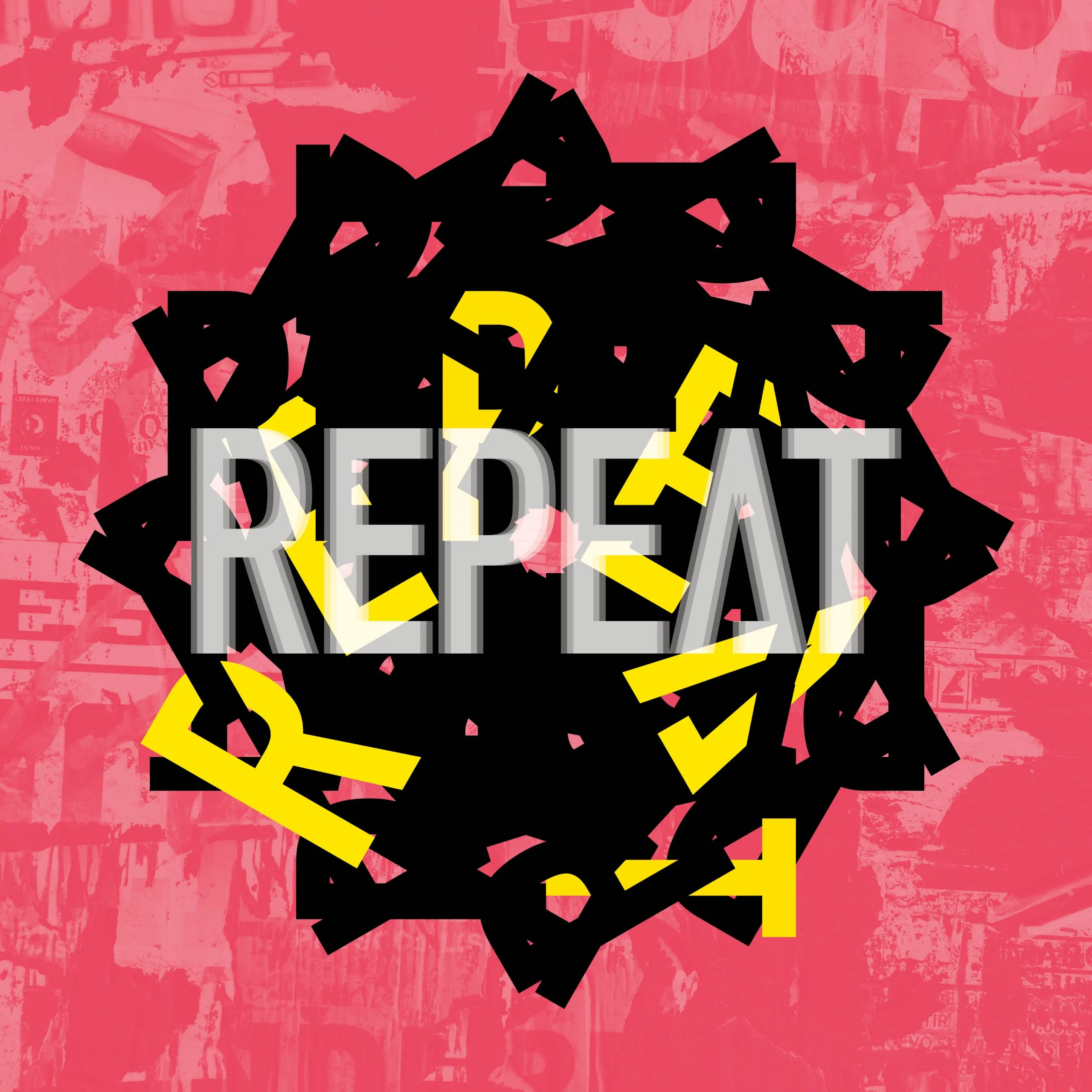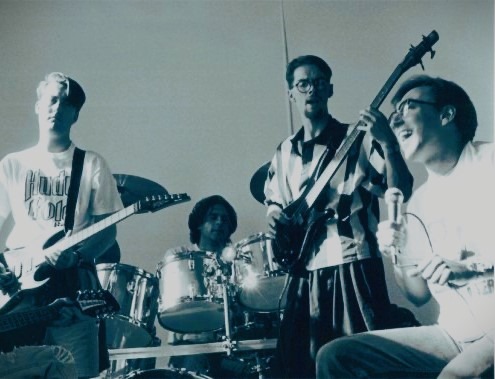Emerging from the underground scenes of Ukraine, New Laconia is more than just a musical endeavor. It is an imaginative exploration of storytelling through sound, a layered and cinematic voyage masterminded by experimental artist Alex Syniakov, based in the city of Dnipro. Unlike traditional music acts, New Laconia operates as a universe in motion, where the lines between fiction and sound blur. Syniakov’s approach is deeply rooted in blending the intellectual with the emotional, the surreal with the tangible. His vision does not simply reflect reality, it distorts and reconfigures it. At the center of this sprawling cosmos lies the Stardust Bear Bazaar, a recurring, interdimensional pub trapped in a time loop. This mythical locale isn’t just a backdrop, but the core of a growing saga where narratives unfold across releases, each song a portal, each melody a memory.
New Laconia thrives at the crossroads of theatrical composition, avant-garde storytelling, and philosophical provocation. With every release, Syniakov furthers the mythos he has constructed, bringing to life a place that feels as real as it is imaginary. The Stardust Bear Bazaar is a symbolic refuge, a timeless, transient space where travelers of countless dimensions gather, share stories, and wrestle with the forces that shape existence. Here, music is not merely an aesthetic experience but a vehicle for narrative immersion and metaphysical inquiry. While others aim to entertain, Syniakov invites listeners to question, to feel, to lose themselves in soundscapes that are chaotic and cohesive in equal measure. The project stands as a testament to the potential of music to act as an art form unbound by genre, convention, or chronology.
Released on July 2, 2025, “Stardust Bear Bazaar, Pt. 2” is not merely a follow-up to its predecessor but a dimensional leap forward. It plunges listeners once more into the expansive world of the Bazaar, where characters like The Stranger and the menacing entity known as Time return with greater force. The track does not ease you in, it hurls you through a wormhole of musical innovation and narrative complexity. Blending distorted textures with rich melodies, jazzy saxophone riffs, accordion flourishes, and Middle Eastern motifs, the piece constructs an environment that is both chaotic and meticulously crafted. Every sound feels intentional, like a thread in a larger tapestry. As the story deepens, so does the emotional weight of the music, offering a multilayered listening experience that feels cinematic, immersive, and emotionally sincere.
From the first note, “Stardust Bear Bazaar, Pt. 2” bypasses any need for buildup. It begins with an immediate thrust into its surreal world, as if the story had never stopped unfolding. The vocals enter swiftly, clear, impassioned, and resonant, cutting through layers of distortion and ambient haze with striking intensity. Rather than gently coax the listener, the song commands attention. It feels like entering the middle of an intergalactic stage play, where the lights flicker, the characters are in mid-sentence, and the setting bends through time. The musical elements serve not just to entertain, but to disorient, to teleport. There’s a sense of being inside a narrative whirlwind, where each note carries clues and each lyric hints at a broader, hidden mythology.
As the track progresses, its instrumentation becomes increasingly diverse and captivating. Percussion drifts between bursts of intensity and moments of weightless suspension, while piano melodies stretch like beams of starlight across an endless void. Saxophones swell in and out of the frame, and Arabic motifs lend the song an air of ancient wisdom mixed with futuristic unpredictability. This ever-shifting palette is a deliberate choice. There is no steady rhythm or familiar beat, instead, the music mirrors the metaphysical uncertainty faced by the characters. The drums and bass do not guide, they follow emotion, echoing the ebb and flow of existential tension. That refusal to conform is what gives the track its power. It exists on its own terms, defying musical norms to better embody the story it tells.
What heightens this surreal experience even further is the dynamic interplay of vocal styles. Syniakov masterfully alternates between soaring, melodic passages and raw, spoken-word segments that echo like cryptic broadcasts from the edge of time. These shifts are not arbitrary, they mirror the fractured narrative itself. Melodic lines provide moments of clarity, aching beauty, and reflection, while the grittier spoken parts are urgent, chaotic, and distressed. This juxtaposition evokes a sense of spiritual duality, the tension between serenity and disarray, between destiny and disorder. It also personifies the contrast between The Stranger’s calm introspection and the villain Time’s erratic grip on reality. These opposing vocal textures deepen the emotional complexity of the song, reinforcing the feeling of being caught between dimensions.
Midway through the track, a trumpet enters, not as background decoration but as a central character. Its tone is piercing and noble, drenched in melancholic brilliance, rising above the soundscape like a flare across darkened space. The trumpet does not merely perform, it announces, amplifies, and enhances the song’s emotional climax. It breaks open the atmosphere with cinematic force, then retreats just as gracefully, leaving behind a shimmering echo. This moment stands as one of the track’s most powerful, a musical epiphany that elevates everything around it. When the rougher, spoken vocals return shortly after, the contrast is even starker, giving the illusion that time itself has bent or fractured. The listener feels not just the passing of time, but its manipulation. It’s a breathtaking trick that only reinforces the song’s central themes of distortion and nonlinear experience.
By the time the song nears its conclusion, it becomes clear that “Stardust Bear Bazaar, Pt. 2” is not just a song but an ecosystem. Every sound choice contributes to the larger illusion. From the shimmering strings to the wheezing accordion, from the jazz-inflected reeds to the pulsing rhythmic gaps, each element builds a vivid sonic world. You can almost hear the clatter of ancient glasses, the hum of warped machinery, the silence before a collapse. The production is pristine, despite the track’s embrace of chaos. There is clarity in the madness, with every instrument given space to breathe, to shine, to carry meaning. Even in its most unpredictable shifts, the song never feels scattered. It always circles back to its narrative core, like a story being told in spirals rather than lines.
“Stardust Bear Bazaar, Pt. 2” stands as a masterpiece of conceptual music, one that defies genre classification and challenges conventional listening. It is not simply a continuation of a previous chapter but a deepening of a mythic universe that feels as emotionally real as it is fantastical. New Laconia doesn’t just create music, it sculpts entire dimensions out of sound, pulling listeners into parallel timelines where songs breathe, think, and transform. The track doesn’t seek to be understood in a single listen. Instead, it invites repeated visits, each time revealing something new, something previously hidden. It leaves you questioning your sense of time and reality, not because it’s confusing, but because it’s expansive. In a world that often demands simplicity, New Laconia offers depth. This isn’t music for the background, it is music that asks for your full attention, and rewards it with worlds beyond imagining.



